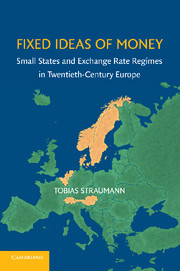Book contents
Three - Fear of Experiments
Published online by Cambridge University Press: 06 July 2010
Summary
In the early 1920s, small neutral states were not willing to opt for a more flexible exchange-rate policy. They viewed the years after the end of World War I as a transitionary period and were not interested in experimenting with new exchange-rate regimes. Eventually, they all restored the gold standard at prewar parity, with Denmark and Norway suffering from a particularly severe deflation. Only Belgium and Finland, two small states that had been involved in the war, stabilized their currencies at a lower level than prewar parity. A new window of opportunity opened in the early 1930s after the United Kingdom suspended the gold standard and allowed the pound to depreciate. The Scandinavian countries followed the British example and now were free to adopt whatever monetary regime they preferred. Did they seize the opportunity this time to make their exchange-rate regime more flexible?
Ever since that period, there has been a widely shared view that Sweden in fact broke with the past and implemented a new monetary policy. Two pieces of evidence are cited. First, the Swedish minister of finance announced in late September 1931 when Sweden abandoned the gold standard that monetary policy would be aimed at stabilizing the domestic price level. Second, Swedish prices were relatively stable after 1931, especially in comparison with countries that maintained the gold standard.
- Type
- Chapter
- Information
- Fixed Ideas of MoneySmall States and Exchange Rate Regimes in Twentieth-Century Europe, pp. 94 - 125Publisher: Cambridge University PressPrint publication year: 2010



